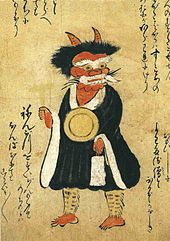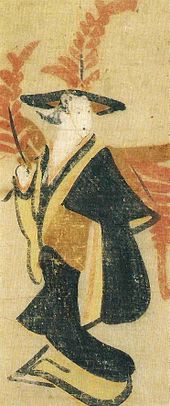Ōtsu-e
Ōtsu-e ( Japanese. 大 津 絵 ) are simple color woodcuts or paintings on paper with Buddhist or humorous motifs that were sold in the city of Ōtsu during the Edo period .
Ōtsu on Lake Biwa was the last stop on the Tōkaidō and Nakasendō highways before the capital Kyoto was reached, or the first station after Kyoto. Therefore the pictures were also called “pictures of the road junction ” ( 道 分 絵 , michiwake-e ). An attraction in Ōtsu was and is the Mii-dera temple , which is also featured in the Eight Views of Lake Biwa . Accordingly, Ōtsu was frequented by travelers who took the Ōtsu-e with them as images of saints or simply as souvenirs.
It is not known how long these pictures have existed, but Hishikawa Moronobu referred to them in a description of the area around 1690. Among the images with Buddhist content, the "Blue Kongo" was popular, which was worshiped by the followers of the popular belief Kōshin ( 庚申 ). Among the secular and humorous images, the "Devil [ Oni ] as Buddha" and the "Wisteria Miss" were particularly popular.
As the examples show, the color scheme in black, brown, red, and occasionally white, on yellow-tinted paper is typical for the Ōtsu pictures. The dimensions are 30–50 cm (height) and 25–35 cm (width).
Below the pictures are:
- Images with Buddhist representations
- Amidha Buddha ( 阿 弥陀 仏 , Amida butsu )
- Thirteen Buddhas ( 十三 仏 , jūsan butsu )
- Blue Kongō ( 青 面 金剛 , Shōmen kongō )
- Thousand armed Kannon ( 千手 観 音 , senju Kannon )
- Acala guardian deity ( 不 動 明王 )
- Worldly images
gallery
literature
- Ōtsu-shi rekishi hakubutsukan (Ed.): Koto no irodori. 1992.





